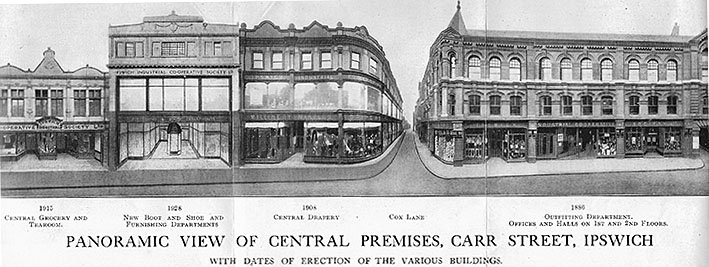- Screen Colours:
- Normal
- Black & Yellow
‘The five buildings on the southern side of the east end of Carr Street have, for over a century, been the go-to centre for every need. They have been standing deserted for a decade. Whilst none are nationally listed, two are on the Local List. It has been known for some time that the Department for Education (DfE) were supporting the proposal of Active Learning Trust (ALT) to SCC’s education department to build a new primary school to serve the young residential population of the town centre. (ALT now has 21schools in the east of England including Sidegate, Hillside and Gusford, plus Chantry Academy in Ipswich). Facading would be expensive and the DfE would not pay for it and, indeed, it couldn’t be incorporated into a modern primary school so all the Co-op buildings east of Cox Lane will be demolished and replaced by a two- storey, 230-place primary school. The main entrance would be from Carr Street with a drop-off point in what is now the Co-op car park. There would be a Multi Use Games Area (MUGA) on the roof. The lettering from the Co-op would be retained and put on the school’s facade. No mention has been made of the rear mosaic but we were assured it will be retained somewhere.’
Mike Cook
Below: fold-out taken from ‘Through Sixty Years' - Ipswich Industrial Co-operative Society, March 1928

The former Co-op buildings in Carr Street are certainly worthy of preservation. The Ipswich Society has argued this point throughout the various planning processes including me speaking against the application at the Development Control meeting a year ago. To make my point I held up photographs of some important Ipswich buildings lost to redevelopment over the years, and strongly put the case that Ipswich's rich history was gradually being eroded by short term planning decisions.
We also suggested that there was a perfectly adequate site immediately adjacent (the former Co-op garden centre), or that the more recent building closer to Majors Corner could be demolished and the site used. Alas, to no avail, the planners can do little other than either 'pass' or 'refuse' the application, and there were very few grounds for refusal.
We did manage to persuade them to include a requirement to 'save' the mosaic, and the historic lettering which together with other 'conditions' has pushed the estimated cost well over the Dept for Education budget – hence the delay in getting started. We understand the contract has now been agreed and the school is planned to open in September 2025.
Incidentally, it is almost impossible to change a planning decision, once granted – the Planning Committee cannot change their mind, irrespective of logic, common sense or good practice. We could ask for a Judicial Review if we thought the planning process was flawed (it wasn't) but such a process is incredibly expensive.
John Norman